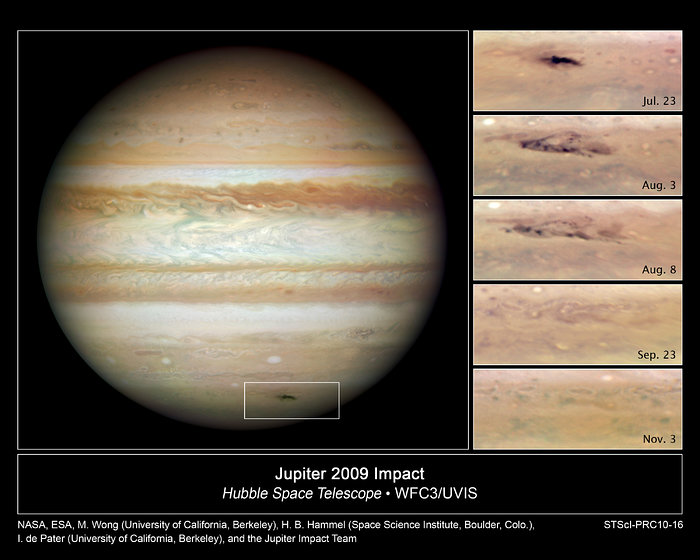Jupiter impact scar is going, going, gone
These NASA/ESA Hubble Space Telescope snapshots reveal an impact scar on Jupiter fading from view over several months between July 2009 and November 2009.
The Hubble image of Jupiter's full disk was taken on 23 July 2009, revealing an elongated, dark spot at lower, right (inside the rectangular box).
The photograph was taken four days after an amateur astronomer first spotted the scar. The unexpected blemish was created when an unknown object plunged into Jupiter and exploded, scattering debris into the giant planet's cloud tops. The strike was equal to the explosion of a few thousand standard nuclear bombs.
The series of close-up images at right, taken between 23 July 2009 and 3 November 2009, show the impact site rapidly disappearing. Jupiter's winds also are spreading the debris into intricate swirls.
To determine the nature of the culprit that smacked Jupiter, astronomers compared the Hubble images of the 2009 impact site with Hubble photographs of the Comet P/Shoemaker-Levy 9 (SL9) assault on Jupiter in July 1994. In the SL9 collision, more than 20 pieces of a known comet bombarded Jupiter.
Based on that comparison, astronomers say the intruder may have been a rogue asteroid about 500 metres wide. The images of the 2009 impact, therefore, may show for the first time the immediate aftermath of an asteroid striking another planet.
One clue pointing to a possible asteroid strike is the swiftly vanishing impact site, which may be due to a lack of lightweight particles in the debris. An asteroid collision may produce fewer fine particles than a strike by a dusty comet.
The impact site's elongated shape also indicates that the object descended from a shallower angle than the SL9 fragments.
The natural-colour images are composites made from separate exposures in blue, green, and red light.
Credit:NASA & ESA
About the Image
About the Object
| Name: | Jupiter |
|---|---|
| Type: | Solar System : Planet : Type : Gas Giant |
| Category: | Solar System |
Colours & filters
| Band | Wavelength | Telescope |
|---|---|---|
| Optical B | 437 nm |
Hubble Space Telescope
WFC3 |
| Optical V | 408 nm |
Hubble Space Telescope
WFC3 |
| Optical R | 634 nm |
Hubble Space Telescope
WFC3 |
